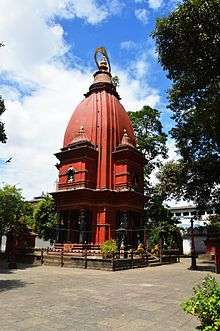Narayanhiti Palace
The Narayanhiti Palace Museum is a public museum in Kathmandu, Nepal[1] located east of the Kaiser Mahal and next to Thamel.[2] The museum was created in 2008 from the complex of the former Narayanhiti Palace (or Narayanhiti Durbar) (Nepali: नारायणहिटी दरवार) following the 2006 revolution.[1] Before the revolution, the palace was the residence and principal workplace of the monarch of the Kingdom of Nepal, and hosted occasions of state.[3][4][5]
| Narayanhiti Royal Palace | |
|---|---|
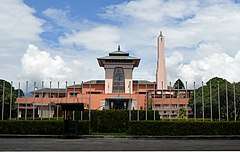 | |
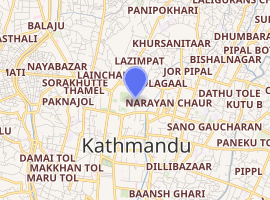
| |
| General information | |
| Town or city | Kathmandu |
| Country | Nepal |
| Construction started | 1963 AD |
| Client | Dhokal Singh Basnyat, King Mahendra, Bir Shumsher JBR |
| Owner | Government of Nepal |
| Technical details | |
| Structural system | Brick and Mortar |
| Size | 38 acres (15 ha) or 753 ropanis |
| Design and construction | |
| Architect | Benjamin Polk |
The existing palace complex was built by King Mahendra in 1963, and incorporates an impressive array of courtyards, gardens and buildings.[2]
Etymology
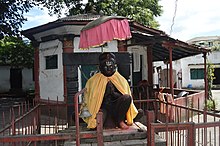
The name, ''Narayanhiti'' is made up of two words ‘Narayana’ and ‘Hiti’. Narayan is the Hindu god Vishnu, whose temple is opposite the palace. ‘Hiti’ means “water spout” in Newar Language, which is to the east of the main entrance in the precincts of the palace, a landmark that features prominently in local legends.
History
Early residences
Ownership of the palace site changed multiple times prior to being occupied by the monarchy. The Shreepali Basnet family occupied the site during the early Shah period. After Dhokal Singh Basnyat, ownership passed to Prime Minister Fateh Jung Shah; his father, Choutaria Pran Shah, also lived on the property.[2] Fateh was killed in the Kot massacre on 19 September 1846 and his family was killed or exiled from Kathmandu.[2]
The property and palace was taken over by Colonel Ranodip Singh Kunwar, the brother of Jung Bahadur Rana, who moved into Choutaria's residence after minor renovations. After Ranodip became prime minister in 1877, the complex was renovated and expanded into a lavish multi-wing palace.[2] Ranodip was assassinated during the coup d'état on 22 November 1885 in the palace's southern wing.[2][6]
Royal residence
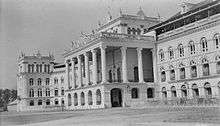
Bir Shumsher Jang Bahadur Rana succeeded Ranodip as Prime Minister and took over the palace. In 1886, Bir Shumsher ordered the old palace demolished, and a new one constructed by architect Jogbir Sthapit as a residence for King Prithvi Bir Bikram Shah, his son-in-law. This moved the royal residence from Hanuman Dhoka Durbar to Narayanhiti.[2]
The palace was damaged in the 1934 Nepal–Bihar earthquake, killing two infant daughters of King Tribhuvan. Colonel Surya Jung Thapa, an engineer, oversaw repairs and renovations which added a new portico and grand staircase.[2]
King Mahendra ordered the palace to be demolished and replaced in 1963. The new palace was designed by American architect Benjamin Polk, who was living in India. Nepalese architecture styles were used to create a national symbol.[7][8][9] Construction ended in 1969. Griha Pravesh (a housewarming party) was performed on 27 February 1970 for the wedding of Crown Prince Birendra.[8]
Mahendra sold the palace to the Government of Nepal in 1972 for NPRरू70 million (seven crore). He claimed that the property was the dowry of Queen Divyeshwari, his paternal grandmother.[2]
On 1 June 2001, Crown Prince Dipendra murdered multiple members of the royal family in the palace before shooting himself. Among those killed were King Birendra and Queen Aishwarya.[10]
Revolution and reuse as a museum
The Nepalese monarchy was abolished following the 2006 revolution. The last king, Gyanendra, vacated Narayanhiti on 11 June 2008. The former palace was used to house the new Narayanhiti Palace Museum.[1]
The royal crown jewels were put on display in October 2018.[1]
Grounds
Design and layout
Gates and boundary walls
Courtyards and Fountains
Military Barack
Helipads
Garage
Mahendra Manzil
Hindu Temple Spire
This is the iconic central tower that rises above the palace in the front. The tower is an extension of the Hindu temple beneath it.[9]
Garuda
The Garuda outside Narayan Mandir in the palace premises is thought to be from Licchavi Period of Nepal.[11]
Cost of building
Interior
The Palace stands on the floorspace 3,794 m² (40838.28 sq ft) and is divided into three parts, the guest wing, the state wing and the private wing. Narayanhiti Palace has 52 rooms called sadan and are named after 75 Districts of Nepal. Interior of the palace is based on Late Victorian style[12]
Reception Hall
Reception Hall of Narayanhiti palace is named after Kaski District as Kaski Sadan. The hall is decorated with two full size taxidermy Bengal tiger in charging posture hunted by King Mahendra and King Birendra along with life-size portraits of the Shah Monarchs throughout the stairs by artist Amar Chitrakar. Gaurishankar Gate opens to Kaski Sadan and it is in Kaski Sadan where Shah Monarchs of Nepal gave audience to politicians and perform oath ceremony of Prime Minister and heads of constitutional bodies for Kingdom of Nepal.
The Throne Room
The throne room Gorkha Baithak is the center of the palace. It is right above Kaski Baithak. Construction of Gorkha Baithak is based on Hindu temple architect style with a 48 feet Chandelier hanging on a 60 feet high Pagoda style ceiling standing on four concrete columns representing Nāga, decorated with garish Hindu deities Astha Matrikas and Ashta Bhairava. It is under this high ceiling where Throne of Kingdom of Nepal was placed. It is this room where the monarch, on special occasions, gave the royal Royal Proclamation.[2] To the right of the Gorkha Baithak, is Dolpa Sadan and was used as the room for the uninvited guests of royal family to view proceedings of Gorkha Baithak through a one-way viewing mirror.
Court ceremonies
Narayanhiti durbar was held in Dhanusha Baithak where the king used to award decorations. It was used for teeka and darshan during Dashain by the royal family and for high level government and military officials.
See also
- Rana palaces of Nepal
- Madan Puraskar Pustakalaya
- Jagadamba Kumari Devi
- Different rooms with different state names
References
- "Crown and scepter put on display at Narayanhiti Museum (in photos)". kathmandupost.com. Retrieved 30 December 2019.
- JBR, PurushottamShamsher (2007). Ranakalin Pramukh Atihasik Darbarharu [Chief Historical Palaces of the Rana Era] (in Nepali). Vidarthi Pustak Bhandar. ISBN 978-9994611027. Retrieved 1 January 2015.
- "Narayanhiti Palace Museum (Kathmandu) - 2019 All You Need to Know BEFORE You Go (with Photos)". TripAdvisor. Retrieved 6 May 2019.
- "A peek inside the palace of Nepal's last monarchy". 27 May 2009. Retrieved 6 May 2019 – via www.theguardian.com.
- Douglas, Ed (27 May 2009). "Nepal's royal palace opens to the public". Retrieved 6 May 2019 – via www.theguardian.com.
- JBR, PurushottamShamsher (1990). Shree Teen Haruko Tathya Britanta (in Nepali). Bhotahity, Kathmandu: Vidarthi Pustak Bhandar. ISBN 99933-39-91-1.
- "The Architecture of Power: Some insights into the Narayanhiti Palace Museum". 8 March 2014. Retrieved 12 October 2015.
- Mark Tushnet; Madhav Khosla (21 August 2015). Unstable Constitutionalism: Law and Politics in South Asia. Cambridge University Press. pp. 74–. ISBN 978-1-316-41908-3.
- Polk, Benjamin (1993). Building for South Asia: An Architectural Autobiography. Abhinav Publications. ISBN 978-81-7017-300-7.
- "Bodyguards fired over Nepal royal massacre". Irish Times. 3 July 2001. Archived from the original on 25 April 2020. Retrieved 19 November 2019.
- Pal, Pratapaditya. Handbuch der Orientalistik: Kunst und Archäologie. 7 Abt. Brill Archive. ISBN 978-90-04-03776-2.
- "General information about killing Narayanhiti Palace Museum". 24 April 2012. Retrieved 12 October 2015.
